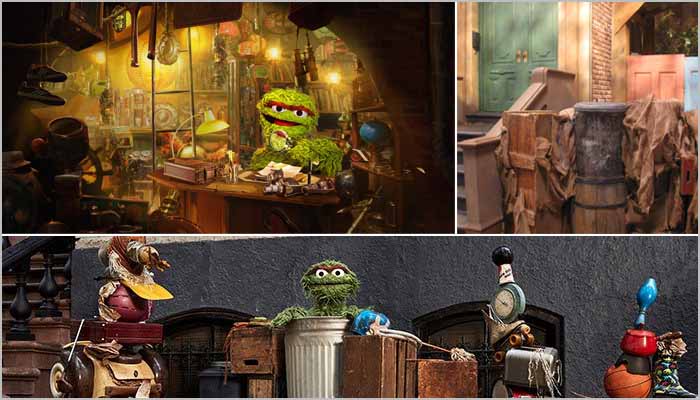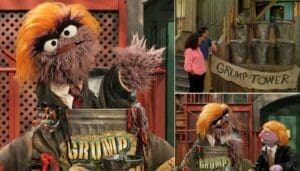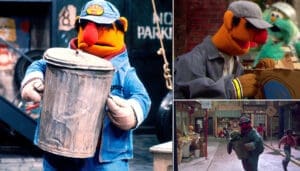For generations, one question has echoed through the minds of Sesame Street viewers, a mystery whispered between giggles and alphabet songs: What exactly is going on inside Oscar the Grouch’s trash can? It’s more than just a prop; it’s an iconic piece of pop culture real estate, a dented, metallic enigma perched curbside between 123 Sesame Street and Big Bird’s nest. The can itself was central from the very beginning; puppeteer Caroll Spinney recounted how, during his audition, Muppets creator Jim Henson simply told him to get in position behind the can and knock. When Spinney, as Oscar, popped the lid yelling, “GET AWAY FROM MY TRASH CAN!”, Henson simply replied, “That’ll do fine”. And just like that, a legend – and his legendary home – was born.
Before we dive headfirst into the can (figuratively, of course – Oscar wouldn’t appreciate the company), let’s reacquaint ourselves with its primary resident. Oscar the Grouch, that furry, famously green Muppet – though originally orange for the first season due to early color TV limitations, a change later explained as a result of a damp vacation in Swamp Mushy Muddy – is Sesame Street’s resident contrarian. He belongs to the “Grouch” species and lives up to the name. He despises all things nice and cheerful, like rainbows and candy , preferring loud noises, rainy days, and arguing. His signature song is literally “I Love Trash” , and his go-to greeting is usually a variation of “Scram!” or “Go away!”. Inspired by a “magnificently rude” waiter or restaurant owner Jim Henson and writer Jon Stone encountered at Oscar’s Salt of the Sea , Oscar is the embodiment of grouchiness. Yet, beneath the grumbling exterior, there are hints of a softer side, particularly towards children, his girlfriend Grundgetta, and his beloved pet worm, Slimey.
This complex personality makes his choice of home even more fascinating. It’s not just a place to live; it’s a statement. Oscar’s trash can, often depicted as a standard metal bin with a hinged lid and an opening in the back for the puppeteer , is a deliberate rejection of conventional comfort and an embrace of what society discards. So, what secrets lie beneath that battered lid? Let’s lift the lid (carefully!) and explore the lore, official revelations, and thematic significance of Oscar’s surprisingly spacious digs.
It’s Bigger on the Inside: The TARDIS Theory of Trash
The most intriguing aspect of Oscar’s trash can is its paradoxical nature. Outwardly, it appears to be nothing more than a standard, dented municipal garbage can. Yet, according to Sesame Street lore and occasional glimpses, its interior defies physics, containing a space far larger than its external dimensions suggest.
This “bigger on the inside” concept isn’t just fan speculation; it’s supported by canonical evidence. Oscar himself has boasted about the extensive amenities within his can. The most definitive visual confirmation came in the 1999 film The Adventures of Elmo in Grouchland. When Elmo dives into the can searching for his lost blanket, he doesn’t just find refuse; he tumbles through a swirling vortex, a messy passage leading directly to the chaotic world of Grouchland, USA. This sequence provided the first substantial on-screen look inside, cementing the can’s status as a magical portal. Further details emerge from books like “What’s in Oscar’s Trash Can? and Other Good-Night Stories” and possibly “The Sesame Street Book & Record,” which reportedly included a map depicting the can’s interior as an underground complex.
This dimensionally transcendental quality has inevitably led fans to draw comparisons to other famous examples of impossible spaces in fiction, most notably the TARDIS from Doctor Who. The appeal lies in the delightful juxtaposition: an utterly mundane, even unpleasant urban object containing a world of extraordinary, magical depth. It injects a dose of pure fantasy into the familiar, grounded setting of Sesame Street, suggesting that wonder and possibility can hide in the most unexpected corners of everyday life. This mirrors the show’s broader philosophy of finding the extraordinary within the ordinary.
However, the can’s nature presents a playful contradiction. In the show’s third season, Oscar reportedly cut holes in the bottom of his can, allowing his legs to protrude so he could walk around, taking his home with him. How can a wearable container also serve as a portal to a sprawling subterranean estate? This seeming inconsistency highlights the flexible, often delightfully absurd logic of the Muppet universe. Perhaps the can’s magical properties only function when stationary, or maybe the creators simply prioritized the comedic or narrative needs of a particular scene over strict dimensional consistency. This internal contradiction becomes part of the fun, emphasizing the playful nature of Oscar’s world where the rules bend to serve imagination.
Inventory of Irritability: What’s Actually Down There?
So, if one were to brave the grouch’s wrath and descend into the can, what might they find? Based on various accounts across Sesame Street media, it’s far more than just crumpled paper and banana peels. Oscar’s can is apparently a veritable underground mansion, tailored perfectly to a Grouch’s sensibilities.
The Grand Tour – Amenities & Features:
Oscar and various sources have claimed the can houses an impressive array of facilities. There’s a swimming pool, a bowling alley, a farm, and even an ice-skating rink (reportedly once graced by skating legend Peggy Fleming). Further explorations, mentioned in sources like Sesame Street Unpaved or a 1970 Look Magazine article, suggest the existence of a piano, an art gallery, a hearth, a train set dubbed “Grouch Central Station,” a pastry kitchen, and even a rococo staircase. Naturally, it also contains more mundane (for Oscar) items like his shoes and a back door.
Roommates, Pets, and Visitors:
Oscar isn’t entirely alone in his subterranean sanctuary. His most cherished companion is Slimey the Worm, an orange invertebrate who is arguably the recipient of Oscar’s rarest commodity: genuine affection. Oscar reportedly found Slimey as a baby worm playing in the mud on a rainy day in the park; the worm crawled up his arm and fell asleep on his shoulder, and Oscar took him home. Slimey, who initially communicated only through squeaks and gestures before developing a digitally enhanced voice , leads quite an adventurous life. He’s been to worm school , participated in worm sports competitions , had a girlfriend named Glo Worm , adopted his own pet bug named Dirty , and even became the first worm on the moon via the Worm Air and Space Agency (WASA). His favorite bedtime story, appropriately, is from the “Trash Gordon” series, often read to him by Oscar.
Beyond Slimey, Oscar’s can has housed a menagerie of other pets, including Fluffy the Elephant , goats, a horse, a dolphin , and Spot the pig. It also serves as a gathering place for fellow Grouches. Frequent visitors include his girlfriend Grundgetta (whom he calls “Grungie” and she calls “Oskie”) , his niece Irvine , his mother , and various other Grouch friends and relatives.
Gateway to Grouchland?
The connection revealed in The Adventures of Elmo in Grouchland suggests the can contains more than just rooms and pets; it holds a door or portal to Grouchland, USA, Oscar’s messy, trash-filled hometown. This links his personal space directly to his cultural roots and the wider Grouch community, known for its unique laws like forbidding the word “please” or asking for help.
This collection of amenities, inhabitants, and connections paints a picture of the trash can not just as a large container, but as a complete, self-sufficient microcosm. It’s a fully realized habitat equipped for leisure, culture, nature, companionship, and even interdimensional travel, all tailored to the specific tastes of a Grouch. This underlying complexity suggests a depth to Oscar’s existence that mirrors the hidden heart often glimpsed beneath his cantankerous surface.
Inventory of Oscar’s Trash Can: A Peek Inside
| Item/Feature/Inhabitant | Description/Details | Source Type | Relevant Snippet ID(s) |
|---|---|---|---|
| Swimming Pool | An aquatic amenity within the can. | Character Claim / Book / Movie Interpretation | |
| Bowling Alley | For recreational strikes and spares. | Character Claim / Book / Movie Interpretation | |
| Piano | A musical instrument, presumably for grouchy tunes. | Character Claim / Book / Movie Interpretation | |
| Farm | Agricultural space within the can. | Character Claim / Movie Interpretation | |
| Ice Rink | Used for skating; Peggy Fleming reportedly visited. | Character Claim / Book / Movie Interpretation | |
| Art Gallery | A space for appreciating (presumably trashy) art. | Book / Article Reference | |
| Hearth | Suggests a fireplace or cozy (in a grouchy way) corner. | Book / Article Reference | |
| Train Set | Referred to as “Grouch Central Station.” | Book / Article Reference | |
| Pastry Kitchen | For baking grouch-approved treats? | Article Reference | |
| Rococo Staircase | An unexpectedly ornate architectural feature. | Article Reference | |
| Slimey the Worm | Oscar’s beloved pet worm, adventurer, and confidante. | Official Show / Movie / Character Relationship | |
| Fluffy the Elephant | One of Oscar’s surprisingly large pets. | Official Show / Character Claim / Book | |
| Other Pets | Includes goats, a horse, a dolphin, Spot the pig. | Character Claim / Book / Official Show | |
| Grundgetta | Oscar’s Grouch girlfriend and best friend. | Official Show / Character Relationship | |
| Grouch Visitors | Includes niece Irvine, his mother, and other Grouch friends/relatives. | Official Show / Character Claim / Book | |
| Door/Portal to Grouchland | Provides access to Oscar’s hometown and the wider Grouch world. | Movie / Character Claim / Fan Interpretation | |
| Oscar’s Shoes | Mentioned as being kept inside the can. | Official Show / Movie Interpretation | |
| Back Door | Another point of entry/exit within the can’s structure. | Official Show / Movie Interpretation |
Home is Where the Heap Is: The Philosophy of the Can
Why would anyone choose to live in a trash can, even one with a bowling alley? For Oscar, it’s fundamental to his identity. His love for trash is legendary, immortalized in his signature song. He actively rejects cleanliness, niceness, and societal norms. His trash can home isn’t a sign of destitution, as some early interpretations or fan theories occasionally suggest ; rather, it’s a deliberate choice, a proud declaration of his Grouch identity and values. It’s his preferred environment, the Grouch equivalent of a luxury condo.
This choice carries significant thematic weight, much of it intended by Sesame Street’s creators. Jim Henson’s initial concept involved integrating Muppet characters directly into the realistic street set, proposing both a giant bird and a creature living in a trash can. Oscar was specifically designed to embody and normalize difference. His unique tastes and manners, so contrary to those around him, served as a metaphor for racial, ethnic, and social diversity. The message was clear: Oscar’s lifestyle might be different, even baffling, but it’s his, and it deserves respect. This fosters understanding and tolerance among young viewers. Oscar, in his can, teaches the value of being true to oneself, even when it means going against the grain. He is decidedly not a people-pleaser and remains comfortable in his own green skin.
Interestingly, Oscar’s dedication to accumulating junk makes him something of an accidental environmentalist. His home is filled with recyclable and reusable materials , and his love for trash inadvertently highlights the potential value in discarded items. It’s an irony Oscar himself would surely despise having pointed out – doing something positive while reveling in negativity.
Ultimately, Oscar the Grouch and his unconventional home serve multiple educational purposes. Beyond the obvious lessons in letters and numbers, his character becomes a sophisticated tool for teaching complex social-emotional concepts. Interactions with Oscar encourage empathy and understanding different perspectives. His very existence, embraced by the community despite his grouchiness, models acceptance and tolerance for diversity. Even his chosen habitat subtly touches upon themes of recycling and resourcefulness. The interpretations of his living situation have also evolved over time, reflecting changing societal conversations. While early commentary might have linked him to urban poverty , and some fan discussions explore themes of homelessness or mental health , the predominant narrative, supported by creator intent and the established lore of the can’s surprising comforts, presents him as a proud non-conformist. This layered meaning allows Oscar and his home to remain relevant and thought-provoking across decades.
Conclusion: Appreciating the Grouch’s Abode
So, what lies within Oscar the Grouch’s trash can? The answer is, delightfully, far more than meets the eye. It’s a place of paradox: outwardly mundane, inwardly magical. It boasts an impossible square footage packed with surprising amenities, from swimming pools to portals. It’s home to beloved pets like Slimey the Worm and Fluffy the Elephant, and a welcoming spot (in a Grouchy sort of way) for fellow Grouches like Grundgetta and Irvine. It’s a gateway to Grouchland, USA, connecting Oscar to his roots.
Debuting in 1969 and brought to life for nearly fifty years by the legendary Caroll Spinney before Eric Jacobson took over the role , Oscar remains one of television’s most enduring and uniquely charming characters. His appeal lies not just in his comical cantankerousness, but in his unapologetic authenticity.
His trash can is the ultimate symbol of that authenticity. It’s not just where he lives; it’s a statement of who he is, a rejection of the ordinary, a container of unexpected wonders, and a portal to a world uniquely his own. It’s a reminder that sometimes, the most fascinating things can be found where you least expect them – even in a pile of trash. Now, appreciate it from afar… and SCRAM!




